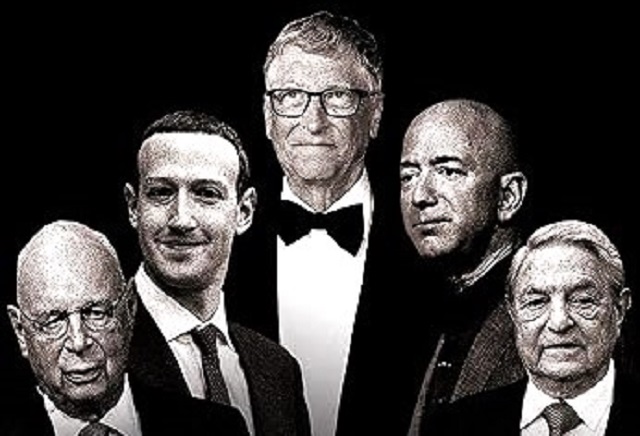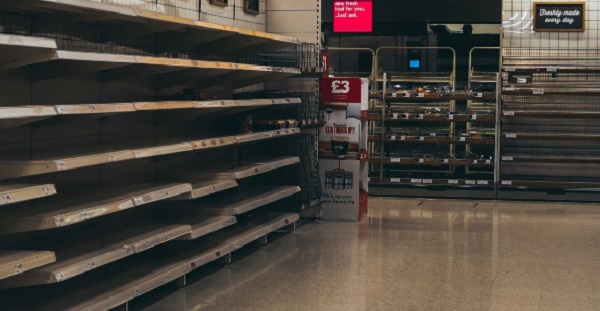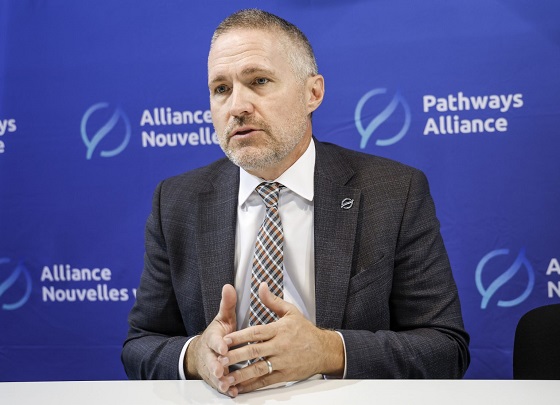Business
‘Controligarchs’ lays bare a nightmare society the globalist elites have in store for humanity

From LifeSiteNews
Journalist Seamus Bruner has published new details on globalist plans to dominate every aspect of our lives, including our food, movement, and transactions
A newly released book gives a fresh, well-documented look into the nightmarish, dystopian society that billionaire globalists are shaping for humanity, in which our every movement and transaction will be tracked, our food will be restricted, and our perception of reality will be heavily manipulated.
Controligarchs: Exposing the Billionaire Class, their Secret Deals, and the Globalist Plot to Dominate Your Life is a thoroughly researched book by investigative journalist Seamus Bruner detailing the global game plan of what he refers to as a new class of oligarchs. They are distinguished from ultra-wealthy elites of the past by the unprecedented level of control they can exercise over the masses through technology, not just over one nation, but over the whole world.
Bruner shows how the globalist elites plan to impose a new kind of serfdom by controlling nearly every facet of our lives, with different billionaires specializing in different areas, beginning with what is most personal to us — our bodies.
After giving a bird’s eye view of the globalists’ plans through the lens of the Great Reset, Bruner dives into each of the globalists’ main levers of power over society, which exert control, respectively, over what goes into our bodies; over home energy use and transportation; over local politics and law enforcement; and over information access and perception.
The journalist first shows how Bill Gates, who already exercises massive sway over world health policy through the World Health Organization (WHO) and investments in vaccines, is also heavily investing in a root source of health: the food supply.
Bruner explains in his book that the “takeover of the food” is accomplished by “controlling the intellectual property of food production through trademarks, copyrights, and patents.” This has already been seen in Gates’ funding and control of seed patents, and in his push for patented synthetic fertilizers, discussed by Bruner, which have caused considerable damage to health and small farms around the world.
The next phase of Gates’ food power grab, which has already begun, involves tighter control over farming through land and water grabs, as well as a push to replace meat consumption with that of synthetic and bug protein.
Bruner emphasizes in his book the importance of control over the water supply, writing, according to the New York Post, “When Gates buys tens of thousands of acres, he is not just buying the land — he is also buying the rights to water below ground. In addition to farms (and the irrigation) and fertilizer, Gates has been hunting for sizable interests in water and water treatment — a crucial component when seeking to control the agricultural industry.”
The journalist also examines how Gates and the “tech oligarchs” are pushing meat alternatives, ostensibly for the sake of the climate.
“I was horrified to learn about the lab-grown hamburgers, fermented fungi protein patties, and even insect-based protein shakes they are hoping the public will consume,” wrote Peter Schweizer, president of the Government Accountability Institute (GAI) and senior editor-at-large of Breitbart News, in his foreword to the book.
Gates has invested millions in companies like Beyond Meat and Impossible Foods, which have already received more than two dozen patents for their synthetic meat and dairy products, and have more than 100 patents pending, according to Bruner. The alternatives aren’t popular now, but about two-thirds of Americans are reportedly willing to try it.
Breitbart reports that Controligarchs also documents the efforts of Mark Zuckerberg to make the Metaverse, a virtual reality platform linked to the internet and operated by Zuckerberg’s Meta Platforms, Inc. (formerly Facebook), “the most addictive product in history.”
Meta and three of its subsidiaries have already been sued by the attorneys general of dozens of U.S. states for having “knowingly designed and deployed harmful features on Instagram and Facebook to purposefully addict children and teens.”
In comparison, the Metaverse, which has been described by the World Economic Forum’s Cathy Li as a kind of virtual world that will “become an extension of reality itself,” and which is designed to feel real with the help of virtual reality (VR) headsets and sensors, has the potential to become far more addictive than mere social media.
While it is still in the process of being developed, progress is steadily being made toward its widespread use. For example, last Thursday, Meta announced a new strategic partnership with China’s Tencent to make VR headsets cheaper and more accessible, according to Breitbart.
And this summer, Apple announced that it would release its own set of augmented reality glasses, called Apple Vision Pro, next year in the U.S.
The plans for the Metaverse get wilder — and for some, creepier. Meta AI researchers are working on a synthetic “skin” “that’s as easy to replace as a bandage,” called ReSkin, as well as “haptic gloves,” so that Metaverse users can “literally feel and grasp the metaverse.”
If it indeed becomes commonplace, as is planned, the Metaverse has enormous implications for society. Perhaps the most serious is that, as John Horvat II has observed, people will feel free to carry out “every fantasy, even the most macabre,” and perceive that they can do things to others “without consequences.”
“Such a lonely world disconnected from reality and the nature of things can feed the unfettered passions that hate all moral restraint. A space like this can quickly go from Alice in Wonderland to insane asylum,” Horvat noted.
Activities performed “in” the Metaverse would also be monitored by the platform’s administrators, drastically diminishing privacy for all Metaverse users.
The assimilation of everyday activities into the World Wide Web via the Metaverse also raises the question of whether any speech performed while “plugged in” to the Metaverse can be regulated by its administrators. Such unprecedented regulatory power would resemble that of a global government, which is an explicit goal of the World Economic Forum, a major supporter of the Metaverse.
The Metaverse may very well be a consolation prize for the restriction of real-life movement and activity, which is planned for all human beings regardless of their participation in the virtual world, according to Bruner.
Bruner shows that the globalists envision a world in which “your every movement” is “tracked and traced by electric vehicles and a smart power grid,” according to Schweizer, with which your thermostat can be turned off without your consent.
In fact, Bruner unveils a $1.2 billion plan by Jeff Bezos to “spy” on citizens using their “smart” homes, which have already been launched by Amazon.
Worse, all “transactions and affiliations” are to be “linked to digital currencies and IDs,” notes Schweizer, plans that have been in the works for years by global bodies such as the European Union (EU) and WHO, as well as nations worldwide.
Most recently, the Group of 20 (G20) — the 19 most influential countries on earth plus the European Union — has endorsed proposals to explore development of a “digital public infrastructure,” including digital identification systems and potentially a centralized digital currency.
Bruner’s description of the globalist plan for our lives is not speculation by any stretch but is based on thorough documentation, including financial filings, corporate records, and admissions from the very globalists themselves. This makes his book a valuable tool not only for those already acquainted with the Great Reset and its accompanying tyranny but for skeptics.
Bruner has advised, “jealously guard your wallet,” “jealously guard your personal data, especially that of your kids,” and “talk to your legislators and Congressmen and tell them to ban your taxpayer money from funding these initiatives.”
Business
Socialism vs. Capitalism

People criticize capitalism. A recent Axios-Generation poll says, “College students prefer socialism to capitalism.”
Why?
Because they believe absurd myths. Like the claim that the Soviet Union “wasn’t real socialism.”
Socialism guru Noam Chomsky tells students that. He says the Soviet Union “was about as remote from socialism as you could imagine.”
Give me a break.
The Soviets made private business illegal.
If that’s not socialism, I’m not sure what is.
“Socialism means abolishing private property and … replacing it with some form of collective ownership,” explains economist Ben Powell. “The Soviet Union had an abundance of that.”
Socialism always fails. Look at Venezuela, the richest country in Latin America about 40 years ago. Now people there face food shortages, poverty, misery and election outcomes the regime ignores.
But Al Jazeera claims Venezuela’s failure has “little to do with socialism, and a lot to do with poor governance … economic policies have failed to adjust to reality.”
“That’s the nature of socialism!” exclaims Powell. “Economic policies fail to adjust to reality. Economic reality evolves every day. Millions of decentralized entrepreneurs and consumers make fine tuning adjustments.”
Political leaders can’t keep up with that.
Still, pundits and politicians tell people, socialism does work — in Scandinavia.
“Mad Money’s Jim Cramer calls Norway “as socialist as they come!”
This too is nonsense.
“Sweden isn’t socialist,” says Powell. “Volvo is a private company. Restaurants, hotels, they’re privately owned.”
Norway, Denmark and Sweden are all free market economies.
Denmark’s former prime minister was so annoyed with economically ignorant Americans like Bernie Sanders calling Scandanavia “socialist,” he came to America to tell Harvard students that his country “is far from a socialist planned economy. Denmark is a market economy.”
Powell says young people “hear the preaching of socialism, about equality, but they don’t look on what it actually delivers: poverty, starvation, early death.”
For thousands of years, the world had almost no wealth creation. Then, some countries tried capitalism. That changed everything.
“In the last 20 years, we’ve seen more humans escape extreme poverty than any other time in human history, and that’s because of markets,” says Powell.
Capitalism makes poor people richer.
Former Rep. Jamaal Bowman (D-N.Y.) calls capitalism “slavery by another name.”
Rep. Alexandria Ocasio-Cortez (D-N.Y.) claims, “No one ever makes a billion dollars. You take a billion dollars.”
That’s another myth.
People think there’s a fixed amount of money. So when someone gets rich, others lose.
But it’s not true. In a free market, the only way entrepreneurs can get rich is by creating new wealth.
Yes, Steve Jobs pocketed billions, but by creating Apple, he gave the rest of us even more. He invented technology that makes all of us better off.
“I hope that we get 100 new super billionaires,” says economist Dan Mitchell, “because that means 100 new people figured out ways to make the rest of our lives better off.”
Former Labor Secretary Robert Reich advocates the opposite: “Let’s abolish billionaires,” he says.
He misses the most important fact about capitalism: it’s voluntary.
“I’m not giving Jeff Bezos any money unless he’s selling me something that I value more than that money,” says Mitchell.
It’s why under capitalism, the poor and middle class get richer, too.
“The economic pie grows,” says Mitchell. “We are much richer than our grandparents.”
When the media say the “middle class is in decline,” they’re technically right, but they don’t understand why it’s shrinking.
“It’s shrinking because more and more people are moving into upper income quintiles,” says Mitchell. “The rich get richer in a capitalist society. But guess what? The rest of us get richer as well.”
I cover more myths about socialism and capitalism in my new video.
Business
Residents in economically free states reap the rewards

From the Fraser Institute
A report published by the Fraser Institute reaffirms just how much more economically free some states are compared with others. These are places where citizens are allowed to make more of their economic choices. Their taxes are lighter, and their regulatory burdens are easier. The benefits for workers, consumers and businesses have been clear for a long time.
There’s another group of states to watch: “movers” that have become much freer in recent decades. These are states that may not be the freest, but they have been cutting taxes and red tape enough to make a big difference.
How do they fare?
I recently explored this question using 22 years of data from the same Economic Freedom of North America index. The index uses 10 variables encompassing government spending, taxation and labour regulation to assess the degree of economic freedom in each of the 50 states.
Some states, such as New Hampshire, have long topped the list. It’s been in the top five for three decades. With little room to grow, the Granite State’s level of economic freedom hasn’t budged much lately. Others, such as Alaska, have significantly improved economic freedom over the last two decades. Because it started so low, it remains relatively unfree at 43rd out of 50.
Three states—North Carolina, North Dakota and Idaho—have managed to markedly increase and rank highly on economic freedom.
In 2000, North Carolina was the 19th most economically free state in the union. Though its labour market was relatively unhindered by the state’s government, its top marginal income tax rate was America’s ninth-highest, and it spent more money than most states.
From 2013 to 2022, North Carolina reduced its top marginal income tax rate from 7.75 per cent to 4.99 per cent, reduced government employment and allowed the minimum wage to fall relative to per-capita income. By 2022, it had the second-freest labour market in the country and was ninth in overall economic freedom.
North Dakota took a similar path, reducing its 5.54 per cent top income tax rate to 2.9 per cent, scaling back government employment, and lowering its minimum wage to better reflect local incomes. It went from the 27th most economically free state in the union in 2000 to the 10th freest by 2022.
Idaho saw the most significant improvement. The Gem State has steadily improved spending, taxing and labour market freedom, allowing it to rise from the 28th most economically free state in 2000 to the eighth freest in 2022.
We can contrast these three states with a group that has achieved equal and opposite distinction: California, Delaware, New Jersey and Maryland have managed to decrease economic freedom and end up among the least free overall.
What was the result?
The economies of the three liberating states have enjoyed almost twice as much economic growth. Controlling for inflation, North Carolina, North Dakota and Idaho grew an average of 41 per cent since 2010. The four repressors grew by just 24 per cent.
Among liberators, statewide personal income grew 47 per cent from 2010 to 2022. Among repressors, it grew just 26 per cent.
In fact, when it comes to income growth per person, increases in economic freedom seem to matter even more than a state’s overall, long-term level of freedom. Meanwhile, when it comes to population growth, placing highly over longer periods of time matters more.
The liberators are not unique. There’s now a large body of international evidence documenting the freedom-prosperity connection. At the state level, high and growing levels of economic freedom go hand-in-hand with higher levels of income, entrepreneurship, in-migration and income mobility. In economically free states, incomes tend to grow faster at the top and bottom of the income ladder.
These states suffer less poverty, homelessness and food insecurity and may even have marginally happier, more philanthropic and more tolerant populations.
In short, liberation works. Repression doesn’t.
-

 armed forces1 day ago
armed forces1 day agoRemembering Afghanistan and the sacrifices of our military families
-

 Opinion1 day ago
Opinion1 day agoPope Leo XIV’s Christmas night homily
-

 Fraser Institute1 day ago
Fraser Institute1 day agoHow to talk about housing at the holiday dinner table
-

 Frontier Centre for Public Policy1 day ago
Frontier Centre for Public Policy1 day agoTent Cities Were Rare Five Years Ago. Now They’re Everywhere
-

 Fraser Institute17 hours ago
Fraser Institute17 hours agoCarney government sowing seeds for corruption in Ottawa
-

 Alberta17 hours ago
Alberta17 hours agoAlberta Next Panel calls for less Ottawa—and it could pay off
-

 Bruce Dowbiggin8 hours ago
Bruce Dowbiggin8 hours agoBe Careful What You Wish For In 2026: Mark Carney With A Majority
-

 Alberta8 hours ago
Alberta8 hours agoAlberta project would be “the biggest carbon capture and storage project in the world”










